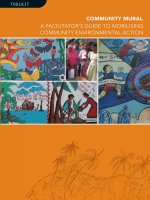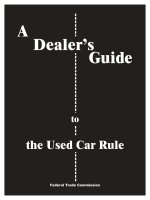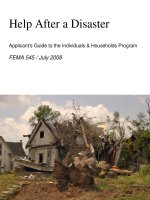Architect''''s Guide to Feng Shui Exploding The Myth pot
Bạn đang xem bản rút gọn của tài liệu. Xem và tải ngay bản đầy đủ của tài liệu tại đây (9.66 MB, 217 trang )
ARCHITECT’S GUIDE TO
Feng Shui
EXPLODING THE MYTH
This Page Intentionally Left Blank
ARCHITECT’S GUIDE TO
Feng Shui
EXPLODING THE MYTH
BY
CATE BRAMBLE
AMSTERDAM BOSTON HEIDELBERG LONDON
NEW YORK OXFORD PARIS SAN DIEGO
SAN FRANCISCO SINGAPORE SYDNEY TOKYO
Architectural Press
An imprint of Elsevier
Linacre House, Jordan Hill, Oxford OX2 8DP
200 Wheeler Road, Burlington, MA 01803
First published 2003
Copyright © 2003, Cate Bramble. All rights reserved
The right of Cate Bramble to be identified as the author of this work
has been asserted in accordance with the Copyright, Designs and
Patents Act 1988
No part of this publication may be reproduced in any material form
(including photocopying or storing in any medium by electronic means
and whether or not transiently or incidentally to some other use of this
publication) without the written permission of the copyright holder except
in accordance with the provisions of the Copyright, Designs and Patents
Act 1988 or under the terms of a licence issued by the Copyright
Licensing Agency Ltd, 90 Tottenham Court Road, London, England W1T
4LP. Applications for the copyright holder's written permission to
reproduce any part of this publication should be addressed
to the publisher
Permissions may be sought directly from Elsevier’s Science and
Technology Rights Department in Oxford, UK: phone: (+44) (0) 1865 843830;
fax: (+44) (0) 1865 853333; e-mail: You may
also complete your request on-line via the Elsevier homepage
(), by selecting ‘Customer Support’ and then
‘Obtaining Permissions’
British Library Cataloguing in Publication Data
A catalogue record for this book is available from the British Library
Library of Congress Cataloguing in Publication Data
A catalogue record for this book is available from the Library of Congress
ISBN 0 7506 56069
Typeset by Newgen Imaging Systems (P)Ltd, Chennai, India
Printed and bound in Great Britain
For information on all Architectural Press publications
visit our website at www.architecturalpress.com
Contents
Acknowledgements vii
Foreword ix
Chapter 1
Introduction: global perspective 3
Chapter 2
Expert rules 17
Chapter 3
Protoscientific and pseudoscientific
conventions 35
Chapter 4
Calculations 57
Chapter 5
Planning 67
Chapter 6
Environmental assessment 85
49
35
81
vi Contents
Chapter 7
Human factors 111
Chapter 8
Crime and its relation to the
environment 127
Chapter 9
Structures 133
Chapter 10
An overview of the theory of
time and space 141
Chapter 11
Form and shape theory in
time and space theory 147
Chapter 12
Services 151
Chapter 13
Overlooked and overblown issues of drainage,
water supply and storage, ventilation, electrical
supply and installation, lighting, and sound 157
Chapter 14
Building elements 165
Chapter 15
Resources 173
Bibliography 177
Index 193
Acknowledgements
I have always relied on the kindness of strangers. This book would
be about parrots had I not had the good luck to study with Master
Larry Sang and to meet Master Joseph Yu, Joey Yap and
Grandmaster Yap Cheng Hai (whose generosity widened my world
to include Master Eva Wong, Master Raymond Lo, and many other
notables in this global community). I may never be able to thank all
of you enough but I will keep trying.
I am also deeply grateful to my friends, most notably Danny Thorn,
Elizabeth Moran, Nani Shaked, and Nancy Chen, who supplied
endless hours of advice, suggestions, enlightenment, encourage-
ment, and humour. Joey Yap and Grandmaster Yap provided
much-needed wisdom. Architects Simona Mainini and David Wong
were kind enough to read the manuscript and provide a much-
needed reality check. Loraine Scott, I cannot thank you enough for
the Mac that I entrusted with my thoughts. It never failed and for
that I am glad.
Without the staff at Architectural Press (Katherine, Alison, and
Elizabeth) none of this would be. Thank you all.
This Page Intentionally Left Blank
Foreword
When I first got onto the internet 5 years ago and searched about
Feng Shui, I was surprised it appeared that this ancient Chinese
practice was quite well received by westerners. However, when I
examined the websites and went to the book stores to find out what
were available, to my dismay, it was not what Feng Shui was meant
to be. I was happy when Cate Bramble’s website ‘Feng Shui for
Dummies’ caught my eyes. The articles not only showed that Cate
was sincere about learning Feng Shui, she was brave enough to
declare war on what was not. She continues to make an effort to
fulfill her mission and her website grows to become ‘Feng Shui
Ultimate Resource’ today.
A lot of Feng-Shui practices can be explained in terms of science.
A lot of Feng Shui theories will be proved using scientific approach
in the future. Although it may take another 1000 years or even
longer before scientists can explain why and how Feng Shui works,
it should be our target. Therefore, the way to study Feng Shui and
other ancient metaphysics is to use a logical system. I am glad that
Cate is following this line.
Cate’s book is timely as there are people who claim to be practising
traditional Feng Shui but they are actually promoting superstition.
This gives a bad name to Feng Shui and gives a bad impression to
scientists, architects, and interior designers. It is true that there are
phenomena that cannot be explained using science. We cannot
use this as an excuse to practise something that insults our com-
mon sense and logical reasoning. Cate’s standpoint is very firm.
x Foreword
I am sure her readers will welcome her effort to dismiss supersti-
tion disguised as Feng Shui.
I am sure architects will find traditional Feng-Shui practices
reasonable after reading this book. We can expect more and more
architects will be interested in designing houses in accordance with
Feng Shui principles.
Joseph Yu
Introduction: global perspective
Macrocosm to microcosm
The jewel that we find, we stop and take it
Because we see it; but what we do not see
We tread upon.
William Shakespeare: Measure for Measure II, 1
Christopher Alexander in A Pattern Language (1977) and The
Timeless Way of Building (1979) says there is only one way to cre-
ate human structures that express our humanity and aliveness.
Perhaps that explains why Benoit Mandelbrot saw fractal structures
only in classic architecture.
1
There must be something to an
ancient building if it has managed to sustain us for thousands of
years and still compels innovative thinkers to return to its fertile
roots.
We want to believe that cities developed almost accidentally,
according to political and commercial interests. We acquire that
idea from our culture, which understands life as linear history
against the traditional view of life as cyclical myth.
2
Yet, cities as we
understand them are a very recent phenomenon for human com-
munities. The current idea developed from something the Greeks
called the polis (which functioned like an extended family) but did
not form what we would identify as a ‘city’ before the European
Middle Ages. Before then, and all around the world until quite
recently, cities were an expression of the sacred.
4 Architect’s Guide to Feng Shui
)LJXUH
9LHZHGIURPDERYH*DXGu·V&DVD0LORORRNV
DVRUJDQLFDQGWLPHOHVVDVDQ\QDWXUDOVHWWLQJ
)URPDPRGHOLQ'HVLJQ:RUNVKRS/LWH
James and Thorpe (1999), in Ancient Mysteries, wonder why our
ancestors shared the urge to reshape the planet for reasons that
do not look quite sane to us. Mound building, straight and wide
paths that run for kilometers to nowhere, stone monuments that
chart the movements of celestial objects, cities that align to the
cardinal directions and whose buildings can be used as astronomi-
cal instruments are part of our human heritage. Wheatley (1971),
in The Pivot of the Four Quarters, showed that urban design
expressed in a variety of Asian literature and architecture, and in
some nineteenth-century American towns, conveyed the same
designs. What were our ancestors thinking?
Human urban design in many places and times has conformed to
the same mythic vision because it most profoundly expresses what
makes us human.The planning of human habitations has generally
been meant for a larger spiritual purpose—and generally an
unconscious one.
3
Traditional habitation seeks to mirror nature’s
ways as a form of respect, and human cultures provide mythic jus-
tification for these acts. Buildings everywhere used to be imbued
Introduction: global perspective 5
)LJXUH
7KH 'RPH RI WKH 5RFN
SURYLGHV WKH VTXDUHG FLUFOH
RIDWUDGLWLRQDOEXLOGLQJ)URP
D PRGHO LQ 'HVLJQ:RUNVKRS
/LWH
6 Architect’s Guide to Feng Shui
with magic, carefull oriented to the heavens and nearby spiritual
features of the land, and integrated with the world at large.
Planetary rotation helped us define cardinal directions which, along
with the centre, ‘here’, assumed importance for humans more than
10000 years ago. Cardinal and intercardinal directions impose
cultural structure on nature and serve as a memory aid that
strengthens and transmits modes of thought over generations.
Humans first mapped the heavens, identified the celestial land-
scape with land formations, and arranged their dwellings and cities
according to the scheme. Settlements were built to invoke these
features. Designing on this scheme revealed the underlying move-
ments of the universe.
Myth provides the ultimate technology because it uses our brain
and its capacity for memes and memeplexes to encode extremely
sophisticated information and transmit it far beyond our own time.
A culture’s myths make it possible for its members to acknowledge
reality (nature). Myth served as the original way to encode tradi-
tional knowledge, including the science of a culture.
Petroglyphs at Teotihuacán orient the city on an east–west axis
with respect to the sky and can be used for astronomy (one pair of
markers indicates the Tropic of Cancer). The Talmud says that if a
town is to be laid out in a square (which identifies what is made by
humans), its sides must correspond to the cardinal directions and
align with Ursa Major and Scorpio (Eruvim 56a). The practices of
al-qibla, built into the Ka’aba and all mosques, orient east and west
sides to sunrise at the summer solstice and sunset at the winter
solstice. The south faces of mosques and the Ka’aba align to the
rising of Suhail (Canopus). Spatial configurations like these form
part of many cultures’ scientific systems, but Westerners often can-
not breach their cultural framework and accept this understanding
of the world.
4
Jauch (1973) in Are Quanta Real? considered that cyclical move-
ment, a common feature in traditional and mythic thought, helps
humans understand the enormity of the universe—including their
own insignificance—as well as reality. (Cyclical thought, in Jauch’s
opinion, is eminently useful today as a heuristic technique simply
because it works so well.) Traditional building provides a way for
humans to be constantly reminded of their insignificance, just as
myths typically celebrate the deeds of those who humble them-
selves. The mythic model articulates a respectful interaction with
nature to draw upon its inspiration and power.
Cosmology and the city
The city of Shang was carefully laid out, it is the centre of the
four quarters; majestic is its fame, bright is its divine power; in
longevity and peace it protects us, the descendants.
From the Book of Odes
Our architecture and other cultural artefacts unconsciously reflect
ideas of cosmic order and embody our values and social reality.
They also have the potential to inspire our species’ more trouble-
some instincts to conform to specific customs. Studies indicate that
our instinctive urges can be guided merely by the presence and
arrangement of nonhuman beings, landscape, and architecture.
Introduction: global perspective 7
)LJXUH
7KH *OREH 7KHDWUH RI
(OL]DEHWKDQ(QJODQGIHDWXUHV
FODVVLF VKDSHV DOLJQHG IRU
JRRG YLHZLQJ DQG DFRXVWLFV
0RUHRYHU WKH EXON RI WKH
EXLOGLQJOLHVDWWKHEDFN)URP
D PRGHO LQ 'HVLJQ:RUNVKRS
/LWH
To the ancients, subtly persuading humans to be their best meant
creating habitations in harmony with nature. The ancients
assessed all probable consequences of erecting a structure on the
balance of nature and designed for the relationship between a
building and the cosmos. Out of Greek geometry a few centuries ago
Western culture fashioned the concept of ‘sacred geometry’ to
supply a spiritual plan for monumental architecture.
5
However,
thousands of years earlier Chinese culture devised its own system—
a radically different approach to addressing the same issues.
Careful planning in traditional building was essential—especially
with capital cities, which assumed the responsibility for the welfare
of a state. What you see in the planning of a traditional city—and
especially in the planning of premodern Chinese cities—flows from
what Mircea Eliade identified as the sacred practice of building.
6
Reality is a function by which humans imitate
the celestial archetype
Trinh Xuan Thuan in Chaos and Harmony (2001) sees the universe
applying certain laws to create diversity. Harmony supplies the pat-
tern and chaos supplies creative freedom. All the high cultures of
Asia and most of the high cultures of the premodern world built
their cities as a terrestrial celebration of the universe.
8 Architect’s Guide to Feng Shui
)LJXUH
$ ODUJHFRPSOH[OLNH.QRVVRV
IROORZVWKHFODVVLFVKDSHVEXW
LW DOVR EULOOLDQWO\ FRQYH\V WKH
JHQLXVRIWKHVRFLHW\WKDWFRQ
VWUXFWHG LW )URP D PRGHO LQ
'HVLJQ:RUNVKRS/LWH
The traditional worldview of Chinese culture supplies a profound
cosmology for generating symbolism. A Chinese city was built only
after a considerable list of requirements was satisfied. Local
influences (xingqi), dynamic powers of what an ancient Roman
might call the genius loci or ‘spirit’ of a place, were determined
before construction in accordance with the shape of local terrain
and the stars and planets wheeling overhead. No expense was
spared to ensure that the city conformed to traditional design
principles. Space–time is paramount in the traditional ideology of
Chinese building, which resides in the ‘Kaogong ji’ (Manual of
Crafts) section of the Zhou li. The site and date for groundbreaking
had to be confirmed by heaven in advance. In the Book of Odes
one Neolithic ruler consults tortoise shells to obtain information
whether a particular area offers the appropriate place and time for
construction.
Introduction: global perspective 9
)LJXUH
7KH3DQWKHRQ FRPSOH[ LV DOLJQHG
V\PPHWULFDOO\ EXW IROORZVWKH SDW
WHUQV KXPDQV H[SHFW )URP D
PRGHOLQ'HVLJQ:RUNVKRS/LWH
10 Architect’s Guide to Feng Shui
Humans mimic the macrocosm and the microcosm by
conducting themselves so that they maintain harmony
between the cosmos and their world
All rites used in the founding of settlements and cities seek to bring
the human world to life within the cosmic scheme. Determining
structural orientation, laying a foundation stone, and performing a
sacrifice express the primordial creation of the world.
Orienting a structure to a particular time and place creates a
microcosm of a meaningful instant. Founding rites also pull a civic
entity from the quantum world (unpredictable, invisible, no direction
of time) into the human one (visible, predictable, distinct matter and
energy, forward direction of time).
Most traditional African religions promote the idea of harmony
between humans, the natural world, and the world that cannot be
seen—which, depending on your viewpoint, could be anything from
spirits to dark matter, bacteria, and viruses. Daoist thinking con-
sists of working with the planet, even to the point of cultivating
‘uselessness’ to avoid exploitation. In China, master builders
applied the primary scientific theories of Chinese civilization to indi-
vidual structures. Significant numbers and celestial objects were
conveyed in the design of government buildings and humble
dwellings,
7
just as Renaissance artists sought to incorporate ‘divine
proportions’ in paintings and monumental architecture. Traditional
Korean architects analysed terrain before building so that
their structures did not usurp the primacy of nature. They hid or
de-emphasized necessary building or engineering devices and
accentuated natural features. Building materials were used as if
they had appeared naturally.
Reality is achieved by participating in a symbolic centre
For example, the circumpolar constellation Purple Palace (Zigong)
was the model for the palace in the Ming city of Beijing.
8
The archi-
tectural symbolism of the centre validated and demonstrated the
power of the emperor who embodied the pole star and the nation’s
subservience to the forces of nature.
Orientation techniques for defining sacred territory in
profane space emphasize the cardinal
compass directions
Many cultures established cities on cosmology. Traditional people
align primary streets to cosmic markers, establish streets on a
cosmic grid, and place major gates on the primary axes. An entire
city (including the palace and related structures) often aligns
with a direction and/or a particular celestial object. A later design
could inherited whatever symbolism accumulated over centuries if
not millennia. This made it simpler for conquerors to legitimize their
rule by utilizing native cosmology and architecture.
Carl Jung thought that four directions were part of human brain
functions, because they often appeared in people’s dreams when
they were stressed. Humans do have an automatic ‘direction
sense’ that provides a frame of reference so that we can orient
(‘east’) ourselves. This innate cognitive map typically provides four
directions (back/front, right/left) and includes a form of internal
compass that provides awareness of familiar environments.
However, it works only if we stay in our home areas. Our cognitive
map includes ‘gestalt laws’ regarding the orientation of buildings to
take advantage of solar gain.
9
Brave new world
It took approximately three centuries of aggressive work to unseat
the traditional view of the world as a holistic system—typically
known to us as ‘paganism’ or ‘primitive superstition’—and replace
it with the rational, Cartesian one. However, a tidal wave of scien-
tific discoveries threatens to resurrect this old worldview—one that
many hoped had been relegated to history (or at least restricted to
pseudoscientists, artistes, and other belittled groups). In a classic
case of ‘revenge effect’ or philosophical hubris,
10
the ancient world-
view has been partially reinstated through rational scientific inquiry
and romantic popularizers such as Fred Alan Wolf and Fritjof
Capra. Evidently, everything is more closely linked than previously
Introduction: global perspective 11
thought, so that the effects of actions are likely to be more widely
felt than previously acknowledged.
11
This is a scary thought to
people who have not adjusted to ideas of nonlinear systems,
quantum mechanics, and chaos theory (sensitivity to initial
conditions)—the scientific concepts that overthrew reductionism
and renewed interest in the ancient worldview.
Claude Lévi-Strauss anticipated that science would eventually be
sophisticated enough to explain the validity of mythological thinking
and help us to close the gap between our mindset and the rest of
the universe. Science can explain how much of what makes us
human is built on metaphors for our experience of the natural
world.
12
Now we have a better understanding of why myth cannot
and should not be eradicated. It is time to engage the natural world
and ancient traditions before they disappear and humanity goes
completely insane.
We have met a traditional human—us
Humans are a product of the natural world and our bodies respond
favourably to the introduction of natural elements because we are
‘hard-wired’ that way.
12 Architect’s Guide to Feng Shui
)LJXUH
7KH3HQWDJRQFRQYH\VFODVVLF
GHVLJQ LQ D IDYRXUHG VKDSH
RI 9LWUXYLXV 3KRWR IURP 86
'HSDUWPHQWRI'HIHQVH
A substantial body of research indicates that human concepts of
what Jiahua Wu (1995) calls ‘landscape aesthetics’ construct the
natural world before the Industrial Revolution. Across national,
racial, and cultural differences, humans largely tend to choose an
unspectacular or even mediocre natural setting over an urban
setting devoid of nature. A large and consistent volume of research
demonstrates the stress-reducing effects of natural settings and
human observation of animals. Other studies conclude that an
appreciation of natural pattern, natural beauty, and natural harmony
are part of humanity’s genetic makeup.
If we succeed in replacing the natural world that shaped us with
objects of our own design our entire species is likely to go mad—if
we are not nearly there already. Science advises us that the
natural world preserves our mental health. That is why pets, ponds,
wild animals, and views of parks and waves reduce our blood
pressure and lower the production of adrenaline. Contrary to
conventional wisdom, crime rates drop when the amount of vege-
tation around us increases.
Humans associate relaxation and peacefulness with natural
settings that include a water feature. We prefer calm water
before us to refresh us and to offer a soothing view. We prefer the
presence of vegetation and animals in our vicinity, and desire a
mountain or other imposing natural feature at our backs. Our early,
not-quite-human ancestors also located their settlements this way.
We also prefer the mechanics and infrastructure of modern living
to be quiet and unobtrusive. Feng shui’s ideal conditions for human
happiness and well-being are programmed into our genes.
Traditional methods of feng shui supply a creative problem-solving
system to analyse the built and natural environments and to better
understand and improve the quality of life. This traditional, sustain-
able philosophy provides time-honoured techniques of environ-
mental protection. On an extremely simplified level, feng shui can
be understood as an attempt to re-establish a dialogue between
humanity’s deepest needs and our long-estranged, much-abused
planet.
Introduction: global perspective 13
A final note
This book is not designed as self-help for the study of feng shui.
You can locate the worthwhile self-help books in Chapter 15, but
none can provide instruction on all aspects of authentic feng shui
and none can compare to study with a competent instructor. What
this book hopes to provide is factual information on aspects of
authentic feng shui practise, and suggestions on integrating princi-
ples of traditional feng shui into the modern practise of architecture.
It hopes to offer a perspective on scientific principles that seem to
underpin certain aspects of the traditional practice.
You definitely will not find much ‘new age’ thinking in these pages
because that mindset has nothing to do with feng shui. Traditional
feng shui is part of Chinese traditional science (ethnoscience) and
follows a long history of interactions and knowledge of the world—
empirical knowledge built up over generations and grounded in
practical evidence.
13
It also emphasizes attachment to place. Anything
‘new age’ (and especially ‘new age’ feng shui which I call McFengshui)
is just nineteenth-century spiritual and occult ideology in posh
packaging.
14
Moreover, ‘new age’ feng shui has no basis in tradi-
tional science, legitimate science, or traditional practices.
If feng shui is going to work in the modern world it has to meet the
world’s criteria. Let us see if it can.
Notes
5HVHDUFKEDVHG RQ DHULDO SKRWRVRI WUDGLWLRQDO VHWWOHPHQWV LQZHVWDQG FHQWUDO$IULFD
VKRZVWKDWWKH\WHQGWRKDYHDIUDFWDOVWUXFWXUHVFDOLQJLQVWUHHWEUDQFKLQJUHFXUVLYHUHF
WDQJXODUHQFORVXUHVFLUFOHVRIFLUFXODUGZHOOLQJVHWF7KHVHDUHWKHUHVXOWRILQWHQWLRQDO
GHVLJQVDQGDUHIRXQGLQRWKHUDUHDVRI$IULFDQPDWHULDOFXOWXUH
0\WKLQRQHDQWKURSRORJLVW·VYLHZFUHDWHVWKHLOOXVLRQWKDWKXPDQVFDQFRQWURODQGFRP
SOHWHO\XQGHUVWDQGWKHXQLYHUVH
,QWKHSUHYDLOLQJVFLHQWLILFYLHZKXPDQVSURFHVVYLVXDOLQIRUPDWLRQRXWVLGHWKHLUIRFXVRI
DWWHQWLRQ VRPH VD\ WKLV KDSSHQV DXWRPDWLFDOO\ &UDYHQ 0RVW RI ZKDW KDSSHQV
ZLWKLQXVLVEH\RQGRXUSHUFHSWXDOUDQJH&RQVFLRXVDQGXQFRQVFLRXVLQWHUSUHWDWLRQVDQG
PRWLYHVRIWHQFRQIOLFW3HRSOHDURXQGXVJHQHUDOO\NQRZEHWWHUDERXWZKDWLVJRLQJRQLQVLGH
XVWKDQZHGREDVHGRQWKHLUREVHUYDWLRQVRIRXUEHKDYLRXU:LOVRQ
14 Architect’s Guide to Feng Shui









